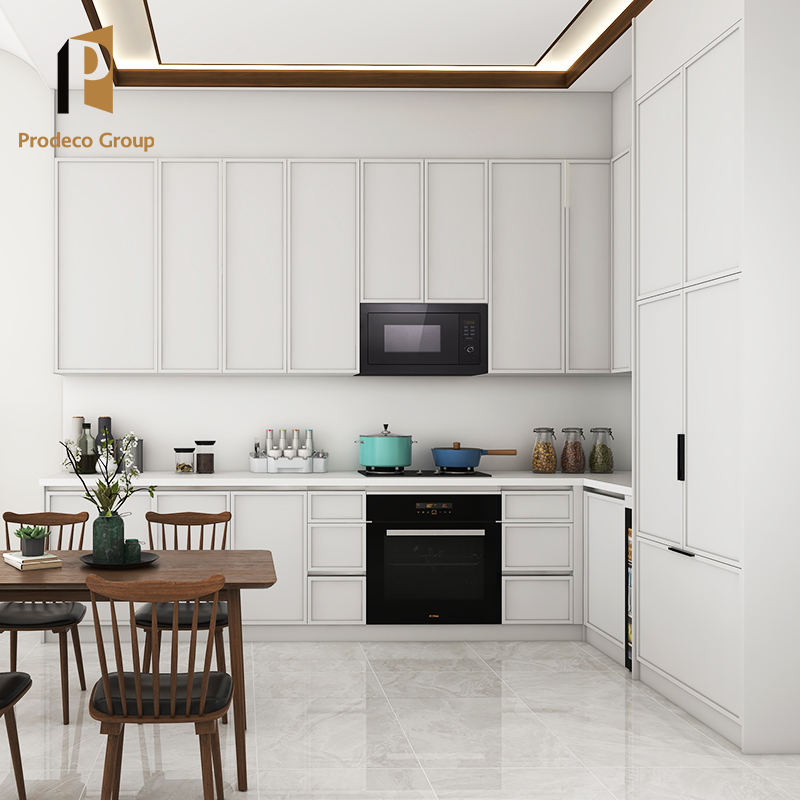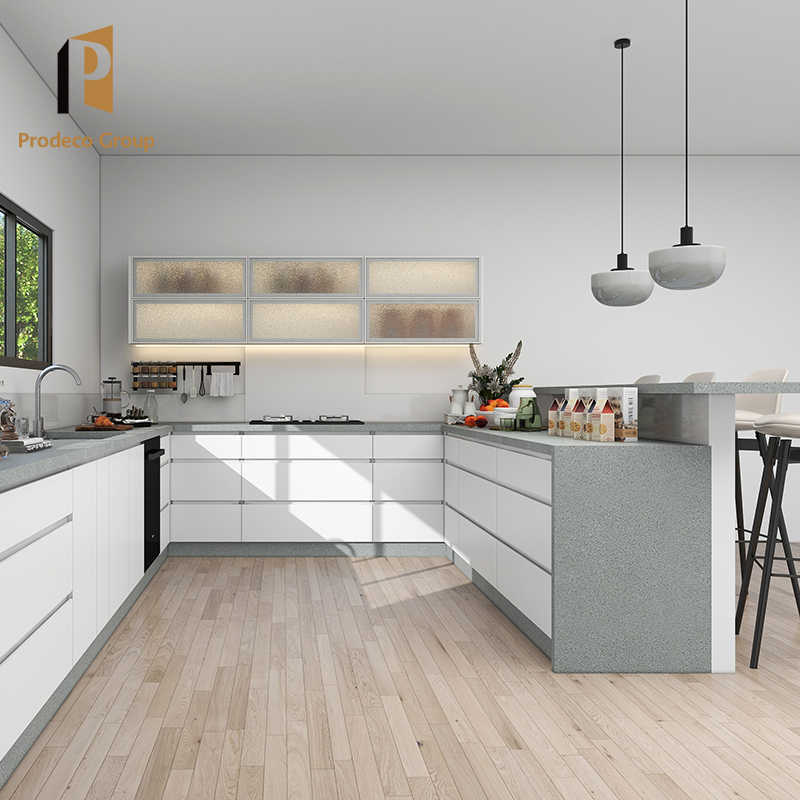1. Base cabinets and countertops of kitchen cabinets
【Features】
This is generally divided into three functional areas: stove area, vegetable preparation area and basin area, which are also necessary areas for all kitchens.
(1) Stove area: It is the area usually used for cooking. Generally, this area is composed of a stove plus a hood or an integrated stove.
The advantage of the integrated stove is that it can save money for a section of the cabinet and countertop in addition to the good effect of fume extraction. The main disadvantage is that it reduces the storage space of about half of the cabinet.
(2) Vegetable preparation area: The area usually used for cutting vegetables and organizing ingredients is an area that is easier to overlook. But it is also a more important area. If the vegetable preparation area is too small, it will cause confusion in the kitchen when cooking.
Generally, the vegetable preparation area is too small. There are two solutions. One is to temporarily change part of the basin area into a vegetable preparation area through the chopping board, and the other is to increase the vegetable preparation area through island.
(3) Basin area: This is mainly the part of washing vegetables and dishes.
There are three ways to install basins: above counter basin, under counter basin, and Taichung basin (a special integrated basin also belongs to Taichung basin).
The difference is the positional relationship between the edge of the basin and the countertop. Above counter basin means the border is on the countertop, under counter basin means the border is under the countertop, and Taichung Basin means the border is flush with the countertop.
【Size Design】
1. Countertop
Depth: Generally, there are three sizes of 350mm, 550mm and 600mm. 350mm is mostly used for sideboards and counter-tops. 550mm is used when the kitchen is relatively small. The most commonly used 600mm countertop is more comfortable to operate.
Height: Normal height is generally height/2+50mm. Generally, the stove area is slightly lower than other areas by 80mm, and the height switch is generally located at the corner. It is not recommended to distinguish between the basin area and the preparation area, otherwise the countertop is too incoherent.
The height of the kitchen cabinets is generally adjusted from one of the three points: the thickness of the countertop, the height of the cabinet and the height of the foot. The most commonly used is to increase or decrease the thickness of the counter and adjust the height of the foot.
Width: each area of the kitchen countertop needs to reserve a certain width
1. The width of the cook-top area is generally greater than 300mm on the left and right sides of the cook-top, which is used for the extension of the arms when cooking and the placement of the dishes;
2. The width of the vegetable preparation area generally needs to be greater than 800mm.
3. The basin area generally excludes the width of the basin, and needs to leave at least 300mm on the side away from the vegetable preparation area, but because the overall width of the countertop is not enough, you can discard it, let the dishes and chopsticks drain on the sink or drain the bowl (there is a drain tray) At the same time, the popularity of dishwashers is increasing, so they can be discarded.
Second, the cabinet
Depth: Generally, the depth is 550mm, which can meet the use of normal hardware. If you need to use IKEA hardware, it needs to be adjusted to 600mm. There may be additional costs due to non-standard needs.
Height: Generally, the height of the cabinet is between 650mm-800mm, but you don’t need to think about it yourself, generally there are standard sizes.
Width: Generally choose between 600mm-900mm, the final width is mainly determined according to the hardware, and the consistency of the cabinet door should be considered.
1. Wall cabinet
【Features】
Almost every part of the kitchen, the main function is to supplement the vertical storage.
The main disadvantage is that it is too expensive to take things. Although there is a drop-down basket to make up for it, the cost is not high because of the high cost. It can be used in combination with open grids to improve convenience.
【Size Design】
Depth: between 300mm-400mm, mainly determined by the depth of the base cabinet, if it is too deep, it is easy to meet.
Height: Generally speaking, the height of the wall cabinet should not be greater than that of the floor cabinet, which is easy to cause the feeling of top-heavy. Therefore, the height of the wall cabinet is generally between 500mm-800mm.
Width: Generally, the width does not exceed 800mm, and the width of a single door is below 400mm.
Suspension height: Generally, where there is a hood, the wall cabinet needs to be hung at 1700mm-1800mm, and the side cabinet can be hung at 1400mm-1600mm.
2. High cabinet
【Features】
Generally speaking, there are three types of high cabinets: refrigerator high cabinets, electrical appliances high cabinets, and storage high cabinets.
(1) Refrigerator high cabinet: Generally speaking, the main function of this high cabinet is to look good as a whole, because the cabinet on the refrigerator generally does not open. As for the size of the refrigerator, in addition to the size of your own kitchen, it also depends on your personal cooking habits. If you like baking, double doors are recommended.
(2) High cabinet for electrical appliances: mainly used to place ovens, steamers, dishwashers, microwave ovens, etc., up and down the same depth, and the depth and width are basically 600mm.
(3) High storage cabinet: Generally, this type of high cabinet is used when the area of the home is relatively large, and it is used with big monster hardware to facilitate the retrieval of items but the cost is relatively high.
Depth: Generally located next to the countertop, in order to facilitate the installation of various embedded electrical appliances, the depth is generally 600mm.
Height: Keep it on the same plane as the highest point of the wall cabinet. The visual effect is good, generally 2200mm-2400mm.
Width: Designed according to the respective sizes of embedded appliances, refrigerators, and hardware.

4. Island
【Features】
The standard configuration of a general open kitchen can be said to be a collection of various functions.
It is not only an extension of the vegetable preparation area, but also a temporary dining table. It also has a powerful storage function. How to use it depends on where you need it.
One small detail is that sockets can be arranged on the middle island, which is convenient for all kinds of small kitchen appliances and mobile phones.
【Size Design】
There is no fixed rule for the size of island.
5. Sideboard
【Features】
Although it is used in restaurants, it is generally custom-made together with cabinets. It is mainly used for storage in restaurants, and can also be used as a separate western kitchen.
【Size Design】
Depth: If used as a western kitchen, the lower part is generally 600mm deep and the upper part is 350mm deep.
If used for storage, the lower part is 450mm deep and the upper part is 250mm deep. The middle can be disconnected or connected.
Height: generally no more than 2400mm.
Width: varies with the width of the restaurant.
6, open grid
【feature design】
It is mostly used under the wall cabinet to put all kinds of condiments and tools that you can use.
【Size Design】
Depth: 200mm-280mm too deep will be touched.
Height: 300mm high so that it is convenient to place various condiments.
Width: The single grid should not exceed 500mm as much as possible, and the design is mainly based on the upper wall cabinet door.

7, aisle
Single aisle: best 900mm wide, at least 700mm wide.
Double aisle: best 1400mm wide, at least 900mm wide.
02 Several combinations and advantages and disadvantages
Generally speaking, there are five types of commonly used layouts, one type, two type, L type, U type and island type.
1. A font
Generally used in the open kitchen of the apartment, the kitchen is located in the corridor, so it is necessary to arrange a row of kitchen cabinets against the wall. The arrangement is also relatively simple. Just follow the order of washing-cutting-frying and calculate the required length of each part.
2. Two font
Generally, there is a living balcony outside the kitchen. At the same time, the kitchen door is facing the balcony door. Because it needs to pass through the middle of the kitchen, it is designed to have cabinets on both sides. The main table is arranged according to a type, and the auxiliary table needs to be designed for follow-up.
But pay attention to several issues. First of all, the aisle is generally more comfortable to be 900mm, and no matter how tight the space is in time, it must be 700mm, otherwise it is inconvenient to use. Secondly, the main table is normally 600mm deep and can be at least 550mm, and the auxiliary table can be at least 350mm. So the total width of the kitchen needs to be at least 1600mm.
3. L type
This is the most commonly used layout, because the kitchen doors in general homes are opened on the edge of a corner, so U-shaped can only be L-shaped.
The usual layout is that the cooking area or washing area is on the short side of the vegetable preparation area and the remaining one is on the long side in order. How to choose mainly depends on the location of gas, flue and water.
4. U-shape
Known as the most perfect kitchen layout, not only does the movement flow smoothly, but also can have a longer countertop in the same space.
But the biggest problem in making U-shaped cabinets is the need for a rectangular kitchen, while the door is open on the long side and cannot have a balcony door.
Therefore, not all kitchens are used, and the U-shaped kitchen has one more corner, although the countertop is longer, but the advantages are limited, so there is no need to force it.
5. Island type
When it comes to the island type, everyone’s first impression is that it can only be used in a large house. In fact, you can use it as long as you want to make an open kitchen. And because of the emergence of integrated stoves, open kitchens don’t have so much oily smoke.
The advantages of an island kitchen are that besides the characteristics of more storage and counter-tops, the most important thing is that its style can be flexible and changeable. More people are involved in cooking.
Recommend several designs of island:
1. Stove and basin island (all the important functions of the kitchen are assembled on the island)
2. The pool and the island in the bar (mainly used as a bar counter with high and low counter-tops, the pool is used for washing fruits and drinking directly, so it is relatively small)
3. Storage and operation of the island (no functional parts are mainly used as an extension of the countertop and storage)
4. Bar counter, operating peninsula (one side of which is connected to the cabinet, it can be made as a high or low countertop or a flat surface)
5. Operation, dining table island (the island combining the operating table and the dining table can integrate the kitchen and the dining room as a whole Good effect)

03 Kitchen cabinets lighting, the most overlooked design
1. Functional lighting layout
Generally speaking, it is better to have separate lighting for several operating areas, rather than just design a ceiling light in the middle of the kitchen.
(1) The stove area (the stove usually has lighting or not), the vegetable preparation area, the basin area, and the middle island area are individually designed for lighting.
(2) If there is no wall cabinet above, it can be designed directly on the roof. If there is a wall cabinet, lamps can be installed under the wall cabinet.
2. Atmosphere lighting layout
(1) Atmospheric lighting of the wall cabinet, such as the door of the wall cabinet and the glass below it, you can design up and down lighting to create the atmosphere light.
(2) Skirting atmosphere lighting, using under the cabinet can make the whole cabinet feel lighter.
(3) Atmospheric lighting of the high cabinet, mainly the light hits the door of the high cabinet, reflecting the texture of the cabinet door.
3. Internal lighting layout
(1) Lighting inside the kitchen cabinets, the light needs to be illuminated from the outside to the inside, so that the inside of the kitchen cabinet can be seen clearly.
(2) Illumination inside the drawer, the light needs to be illuminated from the inside out, so that you can clearly see the items after the drawer is pulled out.
04 Other details that need attention
(1) Towel bar:
It is best to design one or two towel bars in the kitchen cabinets or the middle island, which is very convenient for drying towels or rags.
(2) Wall treatment:
Choose ceramic tiles for the kitchen wall as a whole, and you can use mixed tiles at the shelter of the cabinets. The countertop wall treatment can be used in the middle of the wall cabinet and the floor cabinet, which can be more convenient to clean and improve the appearance.
(3) Guarantee material:
Generally, there are two places in the kitchen: flue and gas pipes that need to be guaranteed, and the materials of the guarantee are ceramic tiles, countertops and cabinet panels.
(4) Top surface treatment:
For enclosed kitchens, you can choose aluminum gusset and gypsum board. Open kitchens can also choose not to have a ceiling. At this time, the exhaust pipes of the range hood and gas water heater must be handled properly.
(5) Space between wall cabinets and high cabinets:
Whether it is a wall cabinet or a tall cabinet, there is a certain distance from the roof. I personally suggest that the gap is less than 100mm and can be blocked with edge banding and decorative strips, otherwise it is better to feel higher than empty.











